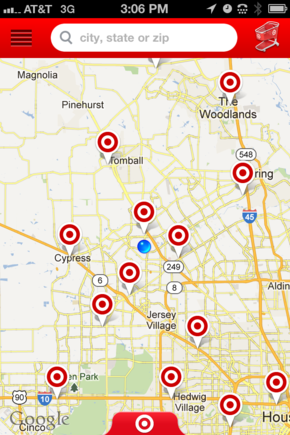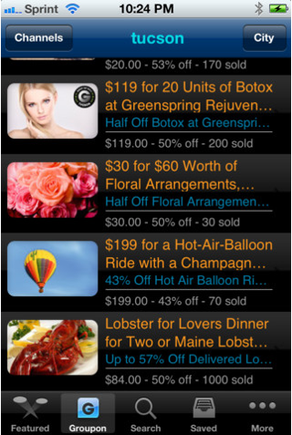In “Getting Started with Responsive Web Design,” my previous article, I stated that there are instances when building a separate mobile app can be beneficial for your ecommerce business. In this article, I will expand on that to present instances where building a mobile app is a good option.
1. Utilize Native Features of the Mobile Device
Many successful apps have been developed to leverage the native features of mobile devices, such as location-based services, camera, bar code scanner, and QR code scanner. If your business can benefit from using these native features, then building a mobile app is a sound and obvious investment.
The most popular native features in apps launched by retailers are store locator, camera, and scanning of bar codes and QR codes. Push notifications are another native feature that is heavily used by retailers in their apps, as it allows them to inform their customers of upcoming events, promotions and new product releases. Push notifications work even when the app is not in use — recognizing that the customer has to first approve the app to send these notifications.
An example of a mobile app using the store locator can be seen in the screenshot of the Target mobile app, below.
The Target app uses the phone’s built-in GPS to show the location of nearby stores.
Native features, at times, help an organization build a new business. For example, an app called TurboScan uses an iPhone or iPad to scan documents into PDF format.
TurboScan utilizes a device’s built-in camera.
2. Utilize Features for Mobile Customers
A business can benefit by offering an app that focuses on key usage scenarios for the mobile consumers. For example, a mobile consumer will likely prefer using image search or bar code product search, versus keyword product search. A mobile consumer will also prefer minimal data entry or gesture recognition. And a mobile consumer is likely to engage in gaming.
Amazon does an excellent job of having targeted features for a mobile customer in the “Price Check” mobile app, which allows a mobile consumer to search for products using keywords, bar code search, image search, or voice search.
Amazon’s Price Check offers several mobile-specific interfaces.
3. Segment Your Mobile Customers
You can create segments based on the type of mobile devices used by consumers. This can be combined with the location and the device’s operating system to create additional segments. You can create different mobile apps for different devices to cater to different customer segments. This allows optimizing the app for each device by offering the best features, user experience, and performance. The app can also be customized based on the customer profile associated with a device. For example, users of the Samsung Galaxy S are likely “value buyers.” Users of the Nokia Lumia 900 are likely “early adopters.”
Segmentation becomes even more important with a global consumer base, as there are more devices and operating systems worldwide that need to be supported.
4. Promote Your Business
There is no reason a mobile app and a mobile website cannot coexist. Mobile apps can be used as marketing and advertising tools to help promote your business, as they offer a more engaging and interactive experience. The app does not always have to be a promotion on products. It can also be used for increasing brand awareness or a story or game to engage your customers in a different way.
Before building the app, a thorough return-on-investment analysis should be conducted to determine if the benefits from the app will be greater than the cost of building and managing it. eBay, for example, uses a separate fashion app to promote its listings for clothing, shoes and accessories.
The eBay fashion app focuses on a specific aspect of its business.
5. Reach More Customers
If you are looking for additional channels to market your business and are not that concerned about the cost or immediate returns, then building a mobile app is a good option. Some customers will prefer using a mobile app — versus a mobile-optimized website — and building the app to reach them will likely increase traffic and could potentially lead to more revenue. However, monitor analytics periodically from the app to determine if this strategy is leading to positive results.
6. Charge Consumers for Your App
If your business can launch an app that consumers would pay for, then the additional revenue from the app could justify the investment in launching it. The app could offer additional features like richer content, ability to organize promotions based on customer interest, add personal notes to products and share them with a social network, and special promotions like free shipping or “buy one get one free.” Below is an example of a deal app that costs $0.99. It consolidates deals from multiple sites and allows filtering of deals by city.
The benefit from an app to consumers can often justify its purchase cost.
7. Improve Internal Productivity
A mobile app can help your company’s productivity. Several large organizations that I work with have mobile apps for their sales teams to manage customer opportunities and maintain history of all customer interactions. Warehouse personnel use apps to scan merchandise quickly on a phone versus buying a separate device. There are several companies that offer frameworks to build these internal apps so a business does not need to start from scratch. Some of the functions offered by the frameworks are collaboration, reporting and business intelligence, security, and integration between apps. The other benefit is that these apps are hosted internally and can be launched quickly without waiting for approval from a third party.
Summary
Before you move forward with any of above options, understand your business needs and how they might influence a mobile app. Also, as those needs evolve, periodically review the decision to use or refine existing mobile apps.





